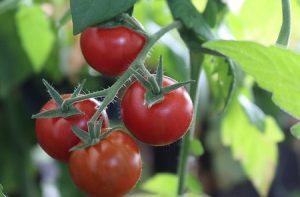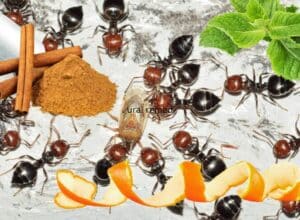Last Updated on October 18, 2023
Ever wonder which vegetables to plant in spring in your garden so you can enjoy home grown produce as early in the season as possible?
And then to be able to plant them in late summer again for fall harvest?
In that case, check out these no-fail fastest growing plants for your spring and late summer garden.
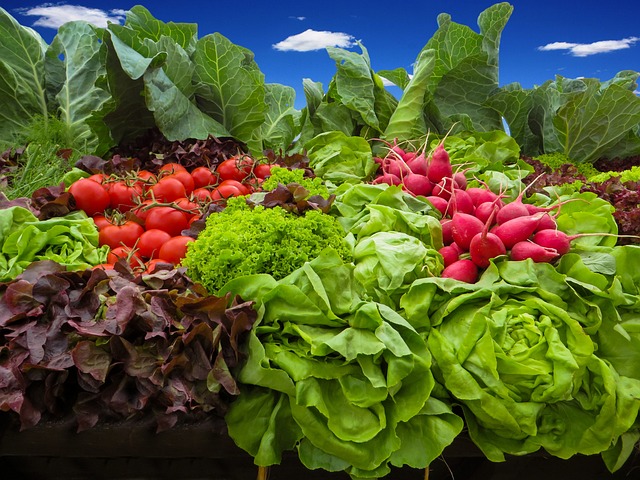
Criteria for choosing plants for your spring garden
I based a selection of vegetables to plant in spring on these criteria:
- Hardy: can tolerate cold temperatures down to 25-28F
- Mature early, so you can start to enjoy your harvest beginning in late spring to early summer
- Easiest to grow (to ensure success for beginner gardeners)
- Prolific producers
- Good candidates for succession planting (plant in 2 week intervals for a continuous supply)
- Suitable for small gardens: grow well in raised beds, containers and planters
- Can be planted again in late summer for fall harvest
All vegetables on the list grow best in the cooler time of the year (when temperatures are between 60 and 75 F). Plant them early in the spring before the last frost date.
*This post contains affiliate links. If you choose to purchase any of the products I have recommended, I may receive a commission at no cost to you.
5 vegetables to plant in spring:
1. RADISH
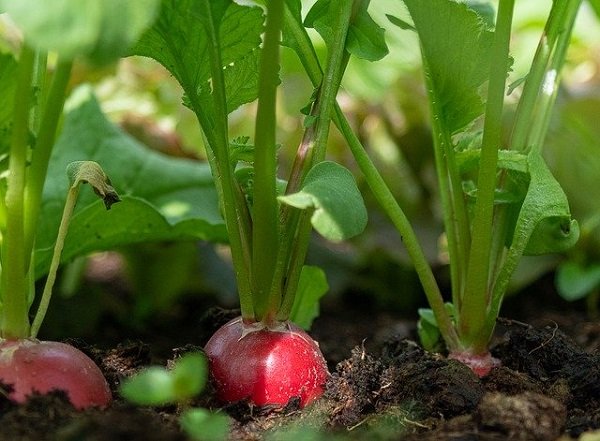
Growing requirements: will grow well in full sun and partial shade. Likes well drained, loose soil.
When to plant: sow seeds 2-3 weeks before average last frost date for your area.
Sowing instructions: plant radish seeds 1/4″ deep, 2″ apart.
Days to emergence: 5-7
Days to maturity: 20-28 days
Best varieties to get: Cherry Belle (mild and sweet), Easter Egg (different colors), White icicle (white and long – carrot shaped).
Tips on growing: interplant radish seeds with slow growing vegetables (for example, carrots). This way, when you harvest radishes, the slower crops will have plenty of room to spread.
You can grow radishes on a sunny windowsill for winter harvests.
What can you use it for? You can eat radishes raw, pickled or even roasted. Try Garden Lady’s Spring Salad recipe, or choose recipes that suits your taste from here.
2. GREEN ONIONS
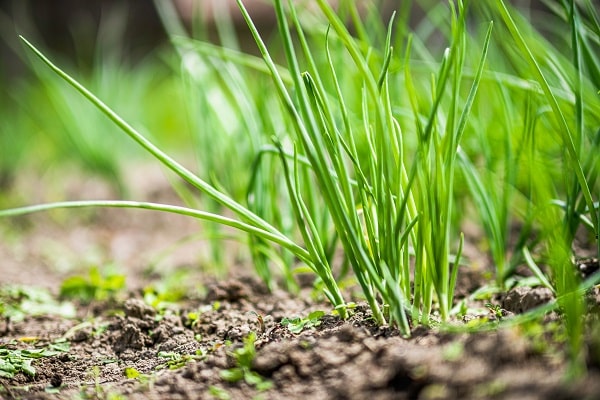
The easiest and fastest way to get a steady supply of green onions in early spring is to grow them from onion sets.
Onion sets are dormant immature onion bulbs grown the previous season. They are around 1/2″ across. Bulbs can be red, white, or yellow. You can buy them from garden centers, or online.
Growing requirements: full sun or partial shade.
When to plant: plant onion sets as soon as the soil can be worked in spring and reaches 35 F. Make sure outdoor temperatures do not go below 20 F (if low temperatures are forecasted, cover the bulbs to protect from freezing).
How to plant: dig the soil until it is loose and well worked. Push each bulb into the soil, so the pointed tip just slightly shows above the ground. Tap the soil lightly to compress it around the bulb.
Days to emergence: 5-7
Days to maturity: 20-30
Best varieties to get: mixed red, yellow, and white onion sets
Useful tip: you can make your own onion sets. To do this, scatter 1 ounce of onion seeds over 2′ x 2′ area in spring. Do not disturb them: do not thin or fertilize them. In mid summer, when the tops die down harvest your onions, select ones that not larger than 3/4 ” in diameter, cure and store them in a dark cool place for planting the following year.
What can you use it for? Use thinly sliced green onions in soups, stews, fried rice, dips, deviled eggs, omelets, grilled meats, potato salad, etc. Spring salad with green onions and radishes is quick and easy to make and tastes so delicious! It is also suitable for keto diet.
3. PEAS
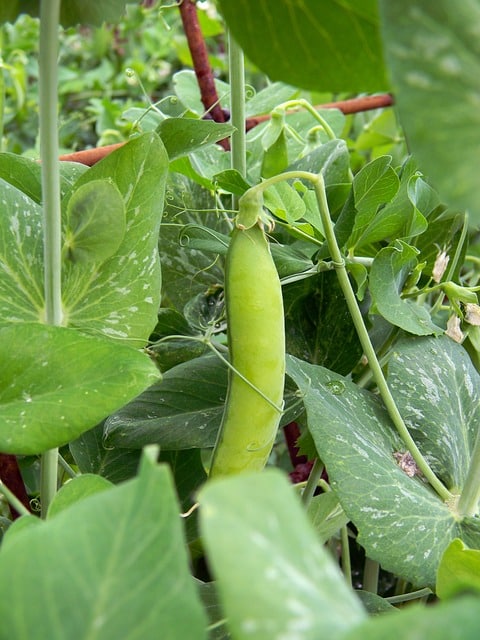
You can plant shelling peas (where you eat just peas, discard shell), and snap peas (edible pod).
Growing requirements: full sun or partial shade, requires well drained soil.
When to plant: Plant seeds early in spring as soon as the soil can be worked
Sowing instructions: 1″ deep, 1 to 4 inches apart.
Days to emergence: 9 -15, can take up to 4 weeks if soil is too cold (40 F)
Days to maturity: Though peas in the pods mature in 53-65 days, you can use other young and tender parts of the pea plant (for example young pea leaves in salads) much – much sooner, because almost every part of the pea plant is edible.
Best varieties to get: semi dwarf very early snap peas (plump pod) – “Sugar Ann” , snow peas (which are snap peas with flat pod) – “Sugar Pod”, shelled garden peas – “Green Arrow”
Useful tip: peas can tolerate moderate freezes. Light freeze damage to shoots can encourage more secondary shoots which will result in more pods per plant.
What can you use them for? Serve peas fresh in salads; eat snap peas with dip, they are also great stir fried or steamed.
4. SWISS CHARD
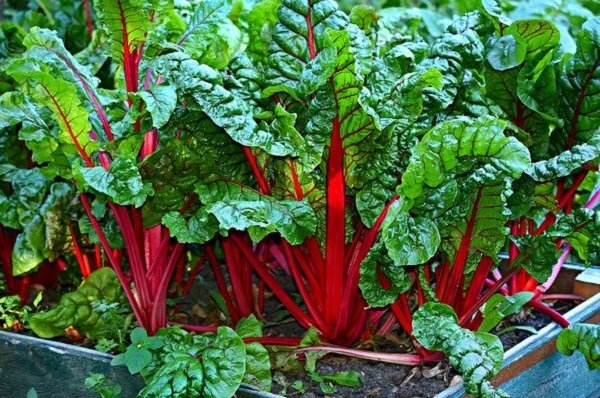
Growing requirements: full sun and partial shade.
When to plant: Plant seeds 2-3 weeks before last expected frost except “Ruby Red” and “Rhubard” varieties.
Sowing instructions: sow seeds 1/2” deep, 6″ apart.
Days to emergence: 5-7
Days to maturity: about 28 days to pick baby leaves for salads, 55 days for mature plant.
Best varieties to get: “Bright Lights“ has leaf stalks that are red, white, orange, purple, gold, and pink.
Useful Tips: harvest outer leaves from each plant. Alternatively, you can cut the whole plant 1-2 inch above the soil and new tender leaves will grow instead.
What can you use it for? Leaves and leafstalks can be consumed. Very young tender leaves are a great addition to salads. Older leaves can be sauteed, leafstalks can be stir fried. Chard is a good substitute for spinach in most recipes. Check out 20 Swiss chard recipes here. Swiss chard is high in oxalic acid, so do not overuse it.
Also, colorful leaves and stalks make chard a great candidate for edible landscaping and ornamental plantings.
5. LEAF LETTUCE & MESCLUN
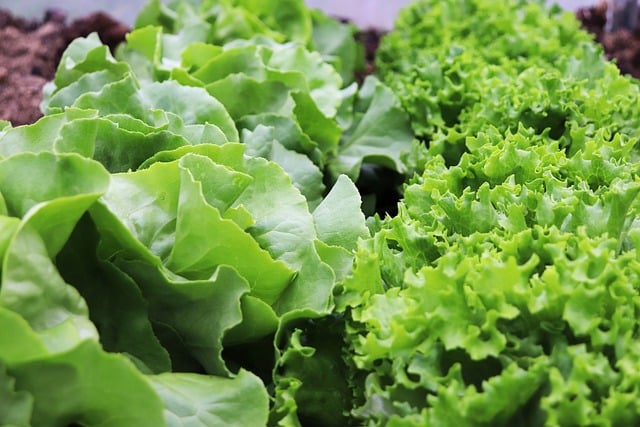
Growing requirements: full sun to partial shade. Needs well drained soil.
When to plant: plant seeds early in spring as soon as the soil can be worked: 2-4 weeks before the last expected frost.
Sowing depth: broadcast seeds and rake gently to cover.
Days to emergence: 7-14
Days to maturity: as baby greens, leaf lettuce is ready to harvest after 2 or 3 weeks. It grows to a full size in six weeks.
Best varieties to get: “Oak Leaf”, “Red Salad Bowl“, “Green Ice”, “Red Sail“
Alternatively, you can plant mesclun (french word for “mixture”) where several varieties of lettuce are premixed with other greens: arugula, chervil, endive, mache, radicchio, and upland cress.
Useful tip: cut a row or patch (if you grow a square foot garden) of lettuce with scissors. The plants will regrow for additional harvest.
What can you use it for? Lettuce is great in salads and sandwiches, and goes well as garnish with almost any dish. You can even make smoothies with it.
Read related:
Can you plant these vegetables in late summer for a late autumn harvest?
Absolutely, yes.
All listed plants can be sown again as summer starts to cool down: around mid-August in North USA, and late August – early September in the South for a late autumn crop. (4 to 6 weeks before your first expected frost).
Plan ahead this year for an early spring harvest next year
This year consider starting some perennial plants that will produce year after year.
You won’t get a spring harvest this year, but early next spring you will be handsomely rewarded!
Here are some suggestions for you.
Sorrel
If you like sorrel soup, (and who doesn’t? ☺️) growing your own sorrel is a no brainer. You can sow sorrel seeds in spring, so your plant will be well established by next year, or in autumn. Read the article How to grow sorrel for detailed information.
Perennial bunching onion
Once planted this kind of onion will produce for many years. It’s easily grown from seeds and never forms bulbs. You can sow perennial onion seeds in fall and mulch them well in order to protect them over winter for the next year early harvest.
Asparagus
Asparagus can be planted from seeds, but you will need to wait 2 years for the first harvest. I would recommend planting asparagus crowns for steady supply of asparagus spears next early spring, and year after year after that.
And if you run out of ideas on what to do with all of the abundance of asparagus – refer to this asparagus cooking guide.
Chives and garlic chives
Chives are very prolific plants! Try to contain them with a barrier or grow in a container, because chives do spread. But they will be first to poke of the ground each early spring to add some oniony and garlicky flavor to your dishes. And their flower buds are edible too.
Chives flowers are really pretty and will look great in your edible landscape.
German and lemon thyme
Thyme is indispensable for marinades, soups, casseroles, and souces. This is a culinary herb I can not do without. Its bittersweet flavor seems right for any dish. Pick a German or lemon variety. In zone 7 (in the USA) thyme overwinters just fine in the ground or even in a patio container.
Thyme can be grown from seeds, but it is so much easier to buy just one plant from Lowes or Home Depot. With time this plant will spread and you will get more thyme than you ever wanted. You will need to divide it every 3-5 years.
An added benefit is that an evergreen thyme plants looks great in any edible landscape.
Read about more perennial herbs you can grow in your garden in Comprehensive Herbs Guide.
Discover more gardening tips on growing and maintaining your garden
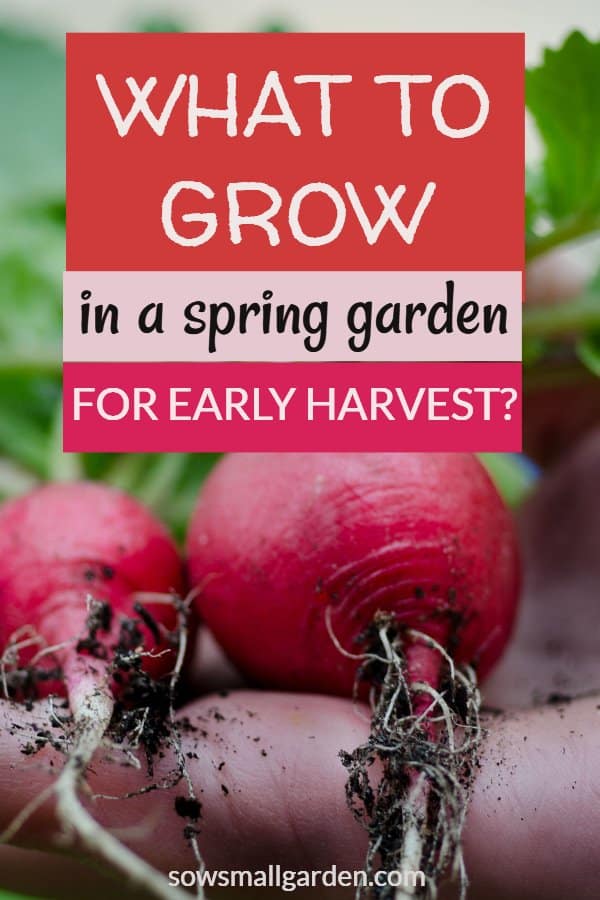
Pin for later reference!
Final thoughts on planting early spring vegetables
Nothing can compare with vegetables and herbs fresh from your garden. And in spring their freshness is especially welcomed.
Plant these fastest growing vegetables in your small garden this year: radishes, lettuce and greens, sweet peas, Swiss chard, and onion sets for early harvest.
And don’t forget to start growing some perennial vegetables and herbs in order to enjoy them early spring next year.
You have read:


